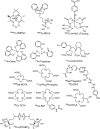Nuclear molecular imaging with nanoparticles: radiochemistry, applications and translation
- PMID: 26133075
- PMCID: PMC4730968
- DOI: 10.1259/bjr.20150185
Nuclear molecular imaging with nanoparticles: radiochemistry, applications and translation
Abstract
Molecular imaging provides considerable insight into biological processes for greater understanding of health and disease. Numerous advances in medical physics, chemistry and biology have driven the growth of this field in the past two decades. With exquisite sensitivity, depth of detection and potential for theranostics, radioactive imaging approaches have played a major role in the emergence of molecular imaging. At the same time, developments in materials science, characterization and synthesis have led to explosive progress in the nanoparticle (NP) sciences. NPs are generally defined as particles with a diameter in the nanometre size range. Unique physical, chemical and biological properties arise at this scale, stimulating interest for applications as diverse as energy production and storage, chemical catalysis and electronics. In biomedicine, NPs have generated perhaps the greatest attention. These materials directly interface with life at the subcellular scale of nucleic acids, membranes and proteins. In this review, we will detail the advances made in combining radioactive imaging and NPs. First, we provide an overview of the NP platforms and their properties. This is followed by a look at methods for radiolabelling NPs with gamma-emitting radionuclides for use in single photon emission CT and planar scintigraphy. Next, utilization of positron-emitting radionuclides for positron emission tomography is considered. Finally, recent advances for multimodal nuclear imaging with NPs and efforts for clinical translation and ongoing trials are discussed.
Figures




Similar articles
-
Aspects of positron emission tomography radiochemistry as relevant for food chemistry.Amino Acids. 2005 Dec;29(4):323-39. doi: 10.1007/s00726-005-0201-1. Epub 2005 Jul 8. Amino Acids. 2005. PMID: 15997412 Review.
-
Nanoparticles and radiotracers: advances toward radionanomedicine.Wiley Interdiscip Rev Nanomed Nanobiotechnol. 2016 Nov;8(6):872-890. doi: 10.1002/wnan.1402. Epub 2016 Mar 23. Wiley Interdiscip Rev Nanomed Nanobiotechnol. 2016. PMID: 27006133 Free PMC article. Review.
-
The chemical tool-kit for molecular imaging with radionuclides in the age of targeted and immune therapy.Cancer Imaging. 2021 Jan 30;21(1):18. doi: 10.1186/s40644-021-00385-8. Cancer Imaging. 2021. PMID: 33516256 Free PMC article. Review.
-
Nanoparticles in practice for molecular-imaging applications: An overview.Acta Biomater. 2016 Sep 1;41:1-16. doi: 10.1016/j.actbio.2016.06.003. Epub 2016 Jun 2. Acta Biomater. 2016. PMID: 27265153 Review.
-
Boron reagents for divergent radiochemistry.Chem Soc Rev. 2018 Sep 17;47(18):6990-7005. doi: 10.1039/c8cs00499d. Chem Soc Rev. 2018. PMID: 30140795 Review.
Cited by
-
Radiolabeled Iron Oxide Nanoparticles as Dual Modality Contrast Agents in SPECT/MRI and PET/MRI.Nanomaterials (Basel). 2023 Jan 27;13(3):503. doi: 10.3390/nano13030503. Nanomaterials (Basel). 2023. PMID: 36770463 Free PMC article. Review.
-
Iron oxide nanoparticulate system as a cornerstone in the effective delivery of Tc-99 m radionuclide: a potential molecular imaging probe for tumor diagnosis.Daru. 2019 Jun;27(1):49-58. doi: 10.1007/s40199-019-00241-y. Epub 2019 Jan 31. Daru. 2019. PMID: 30706223 Free PMC article.
-
Polyethyleneimine-Coated Manganese Oxide Nanoparticles for Targeted Tumor PET/MR Imaging.ACS Appl Mater Interfaces. 2018 Oct 17;10(41):34954-34964. doi: 10.1021/acsami.8b12355. Epub 2018 Oct 4. ACS Appl Mater Interfaces. 2018. PMID: 30234287 Free PMC article.
-
Delivery of cancer therapies by synthetic and bio-inspired nanovectors.Mol Cancer. 2021 Mar 24;20(1):55. doi: 10.1186/s12943-021-01346-2. Mol Cancer. 2021. PMID: 33761944 Free PMC article. Review.
-
Down-Regulation of Toll-Like Receptor 5 (TLR5) Increased VEGFR Expression in Triple Negative Breast Cancer (TNBC) Based on Radionuclide Imaging.Front Oncol. 2021 Jul 15;11:708047. doi: 10.3389/fonc.2021.708047. eCollection 2021. Front Oncol. 2021. PMID: 34336694 Free PMC article.
References
-
- Laverman P, Brouwers AH, Dams ET, Oyen WJ, Storm G, van Rooijen N, et al. . Preclinical and clinical evidence for disappearance of long-circulating characteristics of polyethylene glycol liposomes at low lipid dose. J Pharmacol Exp Ther 2000; 293: 996–1001. - PubMed
Publication types
MeSH terms
Substances
LinkOut - more resources
Full Text Sources
Other Literature Sources
Miscellaneous

